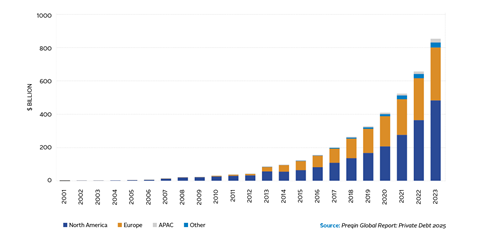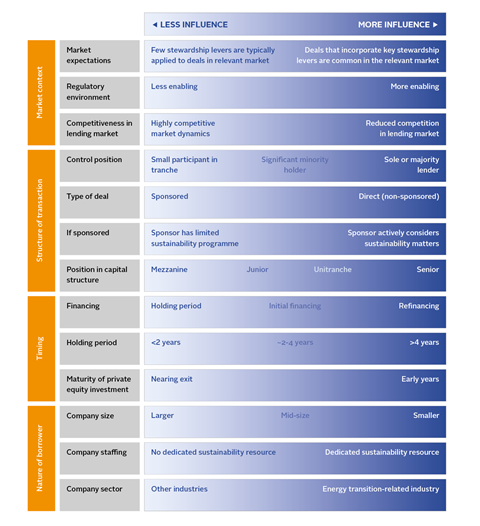This guide aims to clarify stewardship in private debt and offers practical tools and insights to help investors improve their stewardship practices.
Stewardship in private debt is of growing importance due to the significant expansion in this asset class since the 2008 Global Financial Crisis. Private debt is complex and lenders face unique barriers to stewardship that are not present in other asset classes. The purpose of Stewardship in private debt: A technical guide is to acknowledge these challenges while emphasising that there are stewardship actions all private debt investors can take.
While value preservation and the return of capital is the primary motivation for providers of private debt, with effective engagement lenders can also improve the flow of sustainability data and promote practices that preserve or enhance financial value. Features unique to private debt – such as adjusting borrowing costs through margin ratchets – offer lenders meaningful levers for influence.
This guide focuses on direct lending, the largest private debt sub-asset class, so as to provide practical guidance. While we have not explored specifics of stewardship practices in other private debt sub-asset classes, we nevertheless hope that the insights will also be useful for other private debt investors in developing stewardship strategies.
Direct lending AUM by region

The guide includes the following key messages:
Spectrums of influence determine the scope of stewardship activities for private debt investors
These refer to a range of factors affecting the ability of a lender to conduct stewardship. A lender is rarely at the top of every spectrum of influence in each transaction, but equally few lenders are at the bottom of every spectrum. There is nearly always an opportunity to conduct stewardship to some degree.
The spectrums of influence in private debt

There are four key stewardship tools available to private debt investors
Based on discussions with investors in this asset class, these are: sharing resources and providing training; ongoing engagements with sponsors/borrowers; sustainability-related covenants and margin ratchets; and advocacy and collaborative engagements. The first two are standard activities observed across most lenders, while the latter two are more advanced, practiced by fewer, or more common in certain jurisdictions. This guidance includes detailed analysis of these approaches and case studies.
The private debt investment lifecycle includes stages where stewardship is especially effective
Lenders typically have the most influence pre-investment but can continue to engage and apply stewardship tools throughout the holding period. Although deal timelines often prevent finalising stewardship instruments like ratchets before closing, including standardised sustainability clauses in loan documentation, with specific terms finalised post-close, has proven effective.
Stewardship activities across the private debt lifecycle

This guide builds on previous PRI work (ESG incorporation in direct lending) that highlighted the need for industry guidance on how private debt investors can effectively practice stewardship to promote long-term value and sustainable practices among companies they finance.
Its aim is to clarify stewardship in private debt and offer practical tools and strategies for investors to engage borrowers and private equity sponsors. The paper stresses stewardship’s role in reducing risk and supporting value creation, thereby improving the creditworthiness of borrowers.
The research is based on over 20 interviews – conducted between July 2024 and January 2025 – to gather insights on stewardship practices from private debt fund managers (general partners or GPs) and their limited partner (or LP) investors. Initial findings were presented at three practitioner workshops in February 2025, in North America, Europe and Asia, with over 120 participants. Feedback and further insights were collected from market participants, as were the results of a practitioner survey, which inform this guidance.
The PRI selected Redington, a UK-based investment advisory firm with a strong record in sustainable investment and stewardship, to lead the research. The PRI’s Private Debt Advisory Committee supported the design and structure of the guide.
This guide has five sections:
- Understanding stewardship in private debt: Stewardship in private debt is complex, presenting a unique mix of challenges and opportunities to influence outcomes.
- Spectrums of investor influence: An investor’s level of influence depends on factors such as market context, transaction structure, timing and the nature of the borrower. These are key to framing effective stewardship.
- Challenges facing investors: Issues such as timing, access to and responsiveness of the borrower, and data quality affect how well stewardship tools work.
- Stewardship tools: The guidance outlines four main tools: sharing resources and training; ongoing engagement with sponsors/borrowers; sustainability-related margin ratchets and covenants; and advocacy and collaborative engagement.
- Integrating stewardship into the investment lifecycle: Stewardship can be effectively applied throughout the private debt investment lifecycle, from origination to exit.
It also includes two additional sections, one for GPs on resourcing, and another with specific considerations for LPs. Links to related PRI content are provided throughout.
Throughout the guide, readers will find relevant case studies, resources and examples of leading practices.
Download the guide below.
Downloads
Stewardship in private debt: A technical guide
PDF, Size 0.71 mb












